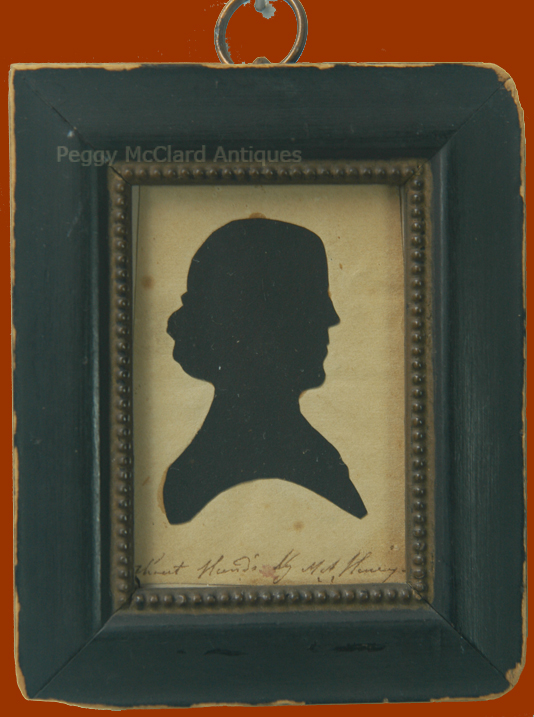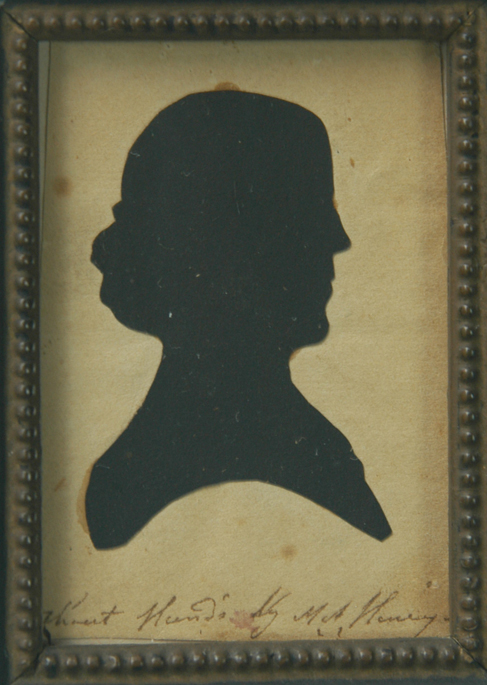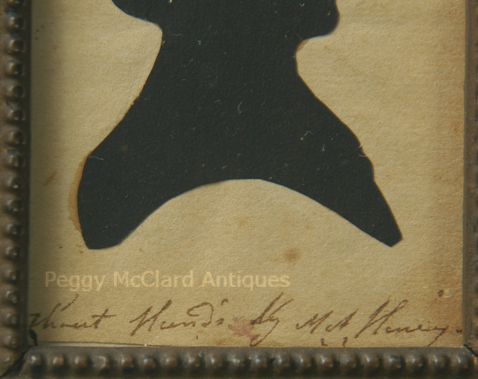
Martha Ann Honeywell (about 1787-after 1848) was a child prodigy. While her silhouettes are naïve, even a bit clumsy, part of the charm of Miss Honeywell’s silhouettes is the triumph to human accomplishments that she could even produce them at all. Miss Honeywell was born around 1787 in Lempster, New Hampshire with only the first joints of both arms, and one foot with only three toes. The first broadsides announcing her profession of profile cutting appear in 1806 and continue until 1848. The signature on Miss Honeywell’s cut & paste silhouettes proclaims either “Cut without hands by M.A. Honeywell” or "Cut with the Mouth by M. A. Honeywell". Most of the silhouettes are plain, but a few gilded examples have been recorded.
While Miss Honeywell was traveling along the Eastern shore board of America and to Europe to cut her silhouettes, she also offered finely stitched needlepoint watch papers, wrote tiny verse with her mouth and did Scherenschnitte (scissor-cuttings). Pictured on the Silhouettist Bios page are examples of both—the needlepoint is wonderfully executed and the verse is so tiny it requires a magnifying glass to read. With magnification, one sees that it is the entire Lord's Prayer, written within less than three-quarters of an inch of paper. See link to Silhouettist Bios below.
I have selfishly collected Honeywell's silhouettes for years but this is the first time I've offered any for sale (and I'm offering two, in separate listings) today. This cut & paste silhouette of a woman is wonderfully representative of her style. It bears the curved bust-termination line that we associate with her. It is simply and naïvely cut. The woman has a simple hairstyle with a hair knot low on the back of her head. Below the profile is her ink signature "Cut without Hands by M.A. Honeywell" although the paper has been slightly cut down and part of the signature is missing. What remains says "thout Hands M.A. Honeywell". Apparently, her profiles were sold to the sitter without a frame, because, when they rarely appear, there are in a variety of frames. Like most itinerant silhouettists, Honeywell used the least expensive paper she could buy (what is referred to as "blue paper" because the rags were not bleached before they were made into a pulp). As a result, and like the work of many American folk artists of the period, the paper on which her work is placed of more often than not stained. The fact that the paper is usually creased also indicates that these silhouettes tended to spend a number of years unframed, likely placed inside the family Bible. In fact, I own one that is still within the Bible in which it was found. This silhouette is in excellent condition for a rare Honeywell silhouette with just a bit of light spotting and, as I noted, the paper has been slightly cut down. It is housed in a period flat profile black painted frame. The inner cover of the frame is carved wood beading in gold paint. The frame is scuffed up and has some wood loss around the edges. Framed size is 4 1/8" x 3 3/8". Sight size is 2 5/8" x 1 3/4".
A wonderful American silhouette by a rarely found and highly sought artist. A great tribute to early disabled artists. Circa 1810-1820.
(#5153) Sale Pending
Published: Page, Melinda, "What to Collect Now: Silhouettes", Country Living Magazine, June 2014, 39-42.
Please see the Silhouettist Biographies page for more information about Martha Ann Honeywell.


